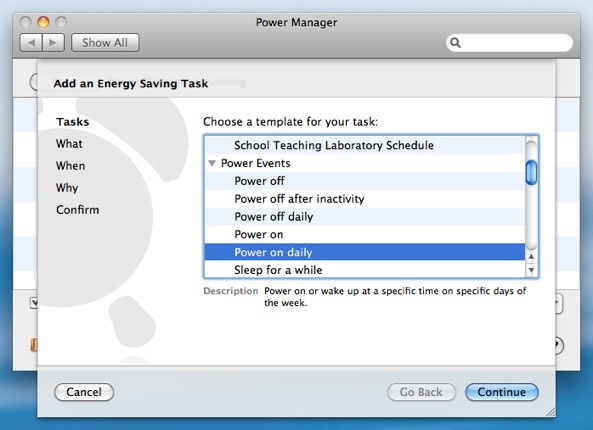

- #Mac power manager mac os
- #Mac power manager drivers
- #Mac power manager driver
- #Mac power manager full
Full information is, as ever, available in its man page, viewed in Terminal by typingĪ good way to start understanding the Power Manager is to ask for a list of the current settings, using It can, like many command line tools, get you into serious trouble requiring SMC and NVRAM resetting, so you must be cautious before making any changes to its settings. Pmset gives you full access to the Power Manager powerd, and can be used to inspect its settings, browse its logs, and to control Power Management in much greater detail than offered even by the full controls in MacPilot.
#Mac power manager drivers
Its value for those not developing hardware drivers is probably very small indeed. This allows you to browse the hierarchy of controllers, ports, and devices in what Apple terms the ‘power plane’. My copy from 2012 still seems to run fine despite its age, but it is no longer a part of Xcode.
#Mac power manager driver
There is another tool which used to be of vital importance to driver developers, IORegistryExplorer, which was supplied as part of Apple’s Xcode development environment. The Power Manager’s role is to manage the transition between different power states – awake and running, sleep, and off – so as to make the most efficient use of power. Power Management, and the Power Manager, work through what Apple terms the I/O Kit, part of OS X which is particularly important to those developing drivers and other support software for peripherals and other hardware devices.

If you want to do anything more sophisticated than the gross controls in Energy Saver, you need to use pmset in Terminal. This is because the settings from Energy Saver are effectively implemented through the pmset command line tool. Third-party tools such as MacPilot offer more controls, but may not have any different effect. Now, in El Capitan, the appearance of, and controls available in, the Energy Saver pane vary according to model, and in many cases offer just a single slider, to control the time to display sleep.
#Mac power manager mac os
Back in the Classic days of Mac OS 9, there were three separate slider controls to allow you to set the time delay before the system (CPU), display, and drives went to sleep, when not being used. Users are supposed to interact with Power Management through the Energy Saver pane, which has become simpler in design, but more confounding in its operation, over the years. However, your logs are likely to be full of many confusing messages, and using them to solve such problems is not easy.

The only general-purpose tool which might help you understand what is going on or wrong is Console, with its log browser. Understanding Power Management in OS X is important when you are puzzled by sleep behaviour, befuddled by the complexities of the Energy Saver pane, or are trying to prevent crashes and freezes which occur on waking or sleeping. It is also sadly uncommon for Macs to crash or freeze when being woken up, and sometimes even when going to sleep. It is quite possible now to configure the settings in the Energy Saver pane to permit hard drives, display, and system sleep, but for only one of those to actually happen. Sleep and its resulting low power consumption are most important for laptops (and iOS devices), in optimising battery endurance – the period of use without mains power supply.Īs with so many features of Macs and OS X, what started off as a relatively simple system has become much more sophisticated, and inevitably far more complex. Waking a sleeping Mac is then far faster than starting up after a period shut down, and can impose less wear and tear on its components. Macs have long had the ability to put some or all of their hardware to ‘sleep’, a state in which they are not exactly turned off, but which uses much less power.


 0 kommentar(er)
0 kommentar(er)
